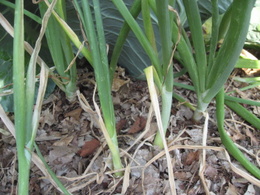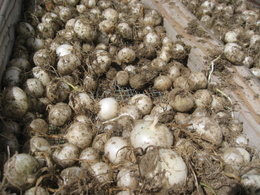Onion Growing Guide
Onions (Allium cepa) are a biennial herb that is most often grown as an annual. They are a common herb that is considered to be essential for good health and is a staple in most kitchens.
It has a characteristic pungent flavor and is related to garlic, shallot, chive and leek. They come in many shapes, sizes and colors ranging from white, yellow and red. The milder red varieties are often added raw to salads.
Soil Preparation
They should be planted in full sun in soil that has enough organic matter and drains well. Wet soil will cause the onion sets to rot. The sets are immature bulbs that were grown the previous summer and can be planted in rows or a container. Till or dig the soil 6 to 12 inches to loosen the soil to allow the roots to fully develop. Soil pH should be 6.2 to 6.8.
Growing Methods
They can be grown from seed or onion sets. Growing onions from seed is more work and requires that the seeds are planted in midsummer densely in a small area.
After about 2-months the tops are knocked down which forces the formation of small bulbs which will be your onion sets. When the tops dry out the small bulbs can be taken out of the ground to cure.
The tops can be cut off and your new onion sets can be stored in a cool dry place over the winter to be planted the following spring. Sets are the way most gardeners grow them.
Onion Types
Day length is what triggers the development of the bulbs. They are generally divided into three categories: short-day, intermediate-day, and long-day.
The southern states, which are closer to the equator, have shorter days than the northern states, which are farther from the equator and have longer days. The intermediate categories are in the middle. The short-day varieties grow best in the southern states, the intermediate-day grows best across the middle states and the long-day grows best in the northern states.
When selecting varieties, remember that "long-day" types will need the 14 to 16-hour days in the Northern zones and “short-day” types will do best with 10 to12-hour days in the Southern zones. Intermediate-day or "Day-neutral" types of onions grow well in most zones.
If you purchase your sets from a local garden center they will have the proper type for your location. All you will need to do is select the variety.
When to Plant
Plant your sets 2 to 3-weeks before the last expected frost in the spring.
Plant the small bulb with the root end down and the growing tip up. Do not plant your sets too deeply. The planting depth can vary depending on the size of the onion set. The growing tip should be even or slightly below the surface spaced 3 to 4-inches apart in rows that are 6 to 12-inches apart.
The small sets send out their roots and begin growing in the cool weather and form bulbs as the weather gets warmer.
Watering and Care
They have a shallow root system and require even moisture throughout their growing season. Water weekly if needed to keep the soil moist.
Do not allow weeds to take over. When pulling out weeds, be careful not to disturb the shallow roots.
The best way to prevent weeds is to apply a 2 or 3-inch layer of mulch, which can be shredded leaves or pine straw shortly after the leaves appear.
Harvesting Onions
Later in the summer the tops will begin to turn yellow and brown. When this happens use your hand to gently bend the tops over horizontally. This stops them from growing and diverts its energy into maturing the bulb.
In a few days the tops will turn brown and on a sunny day they can be carefully dug up. Leave the bulbs out in the sun to dry for 1 to 3-days. If it should rain bring them inside to dry out.
Wipe off any loose soil from the dry skins and place on an old widow screen to finish curing. Do not remove the dried paper skins which will protect the bulb in storage.
Some gardeners like to braid the dry tops and hang them in a cool dry place. Others prefer to cut off the dry tops and store them in a mesh bag or in an open container to allow air circulation around them.
Check them from time to time and toss out any that are soft and may have spoiled. Use up the ones that may be starting to sprout.
Popular Varieties
Short-day varieties: Georgia Sweet, Sweet Red, Texas Super Sweet, Texas Sweet White.
Intermediate-day or Day-neutral varieties: Candy, Red Candy Apple, Super Star.
Long-day varieties: Walla Walla Sweet, White Sweet Spanish, Yellow Sweet Spanish.
Sources: Seeds Now, Burpee, Johnny’s Selected Seeds
Diseases and Pests
Onions are usually a disease and pest-free crop. Most of the fungal and bacterial diseases can be avoided by not over-watering and spacing your plants so that they get good air circulation.
Tips and Warnings
It is not recommended that onions be stored in the refrigerator because the starch in them will convert to sugar and they will dry out faster.
The preferred method of storage is in a well ventilated, cool, dry dark place. Do not store them in plastic bags.
Garden Spikes newsletters give you timely information once or twice a month. Subscribe Free to the Garden Times newsletter below.
Your email address will only be used to send you a newsletter and will never be sold. You can unsubscribe at any time.


